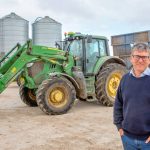
LIC’s Board Chair, Murray King, says the cooperative should be proud that it has built such significant genetic wealth for the New Zealand dairy industry.
“Significant investment has been made to ensure LIC leads the world in pastoral genomic science, the board is pleased to see this paying off, with all shareholders able to share in the productivity and profitability improvements”.
LIC’s General Manager NZ Markets, Malcolm Ellis, says when it comes to breeding, LIC is investing in the long game on behalf of its shareholders, with the big prize to benefit farmers.
“Farmers appreciate the time lag of genetic gain between putting quality genetics into their herd and seeing the resulting benefits. But through sustained farmer shareholder investment and a wealth of genomics data we are delivering an increased rate of genetic gain within the bulls that arrive on farm each year,” says Ellis.
“Coupling this with good cows and a good herd presents a real opportunity to further sharpen up the New Zealand dairy herd’s efficiency – and its ability to deliver significant, sustainable productive and financial gains for farmers and our country overall.”
The use of Genomic Sires has grown significantly since 2017, where just under 400,000 inseminations were completed. This year LIC is expecting to complete 1.4 million genomic inseminations throughout the country, a growth of over 1 million inseminations in just three seasons.
Ellis says LIC is continuing to invest on behalf of its farmer shareholders into R&D including genomics.
“As we invest more into the space, it is pleasing to see more and more farmers utilising genomic sires, creating on-farm value out of an investment that started with innovative foresight nearly 30 years ago.”
LIC’s chief scientist, Richard Spelman, says LIC has been on a genomics journey since the 1990s with the focus being increasing the rate of genetic improvement in New Zealand dairy animals. The cooperative is achieving this by shortening the five-year generation interval by genomically selecting marketable sires up to three years earlier than conventional progeny testing.
“Our journey began in 1994 which was when our gene discovery programme of work commenced,” says Spelman.
“The foresight shown by LIC’s board and shareholders at that time was quite remarkable and it’s what enabled us to develop our platform and build the current genetic wealth our dairy farmers currently share.”
“This science investment has included genotyping over 150 thousand animals, genomically sequencing over one thousand animals and employing smart people to undertake detailed statistical research. This investment has resulted in our work now delivering improved rates of genetic improvement for today’s dairy farmers.”
Spelman also says the journey continues and in February this year LIC released its Single Step Animal Model (SSAM) which uses animal genomic information in a more efficient way; combining ancestry, phenotypic and genomic information all in one step.
“Not only does the SSAM improve the efficiency of our breeding scheme, it also delivers farmers with clearer information on the most profitable and efficient cows on farm for better breeding and culling decisions.”
“We evaluate all information simultaneously compared to previously combined daughter proven data with DNA marker information. By combining all data at once – calculating breeding values for all animals in the population in a single-step, the evaluation is significantly improved.”
Validation of the 2011 to 2014 code cohorts of LIC’s Sire Proving Scheme – animals which now have milking daughters with herd testing data, shows the use of the new SSAM has resulted in an 8% increase in genomic prediction accuracy (i.e. comparing genomic predictions to actual daughter proofs).
Spelman says LIC has added confidence in the model, its results and the new young bulls the cooperative is selecting for breeding.
“We also know that genomic evaluation continues to add value for the lifetime of our bulls. For bulls used over multiple years and in multiple teams, genomics can be adding value a decade after the bull was bred.”
In July 2019, LIC had its 2016 Sire Proving bulls ranked based on SSAM genomic information and they were followed through for the next season as their daughters had their first lactation. The degree of re-ranking with the addition of daughter information was minor with most bulls staying within the quartile they were originally selected.
As well as the 2016 Sire Proving bulls LIC now has information on its 2017 and 2018 Forward Pack teams, the BW they were marketed at, and where they are now compared to daughter proven teams. Again this information shows that while individually animals will re-rank, team BW has been delivered and in many cases, exceeded expectations.
“We are now seeing regular and consistent performance from our genomically selected sires, and our validation is showing that it is likely that a team of bulls will deliver on their genomically predicted BW.”























